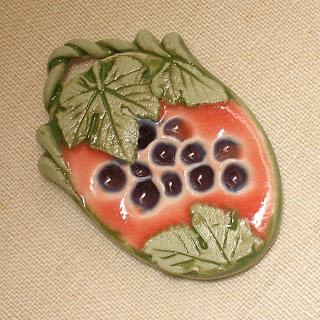Up until May 1967 Wedgwood was still a private company in the hands of the original family. It was chaired by five successive generations of Wedgwoods. Now it is a group of companies with 20 factories and accounts for approximately one fifth of England's ceramic tableware and a quarter of its exported ceramics. (The Story of Wedgwood compiled by Alison Kelly in association with Josiah Wedgwood & Sons Ltd.; Faber & Faber London 1975. Another book fully describing techniques and processes for producing the ware, The Making of Wedgwood may be obtained from Josiah Wedgwood & Sons Ltd., Barlaston, Stoke-on-Trent. Or at least it could in 1975.)
He invented and produced colored, vitreous fine stoneware bodies which he then used as a ground for white, neo-classical, bas relief designs. His blue body is so famous that it is simply known as Wedgwood blue. I think you can see the incredible detail that is achieved from the cameo above which was probably built up from several sprig molds. This piece and many more like it may be seen at this link.
My
understanding of the process is that a white clay is poured or pressed into
shallow molds. The sprigs thus molded are then applied to the contrasting
colored clay of a pot, medallion or cameo. This, at least, was the method I
used. I reversed what Josiah Wedgwood did by using colored clay sprigs on a white background.
I carved two very simple designs directly into some cameo blanks for lack of time to make and bisque a positive image first and then take a mold of it. I made sure to produce rather shallow designs so that they would not stick out too far. But I also made them solid so that they could be handled easily.
I used two different methods to transfer the design to the finished cameo blank. In the first I press-molded colored porcelain in the flower mold, scraped it flush, moistened it with vinegar and then pressed the leather hard cameo blank on top of it. The blank easily lifted the molded flower out of its bisque bed.
The second way that I transferred the design was with the simple expedient of tapping the sprig out of the bisque mold first and picking it up and applying it with vinegar to the blank. This is the way that the above piece was made. The second method made it easier to position disparate elements from separate bisque molds. The first method made it easier to remove narrow or delicate parts from the bisque mold.
An even easier method of obtaining sprigs was used with the grape leaf and grapes pendant at the top of this post. I plucked tiny grape leaves from my grape vine and pressed them into a thin slab of green porcelain. After cutting out around them I applied them to the pendant blank.
As usual I will be uploading the photographs of the Kiln Opening that these pendants came out of to my facebook page as soon as possible. And the individual pendants will more than likely pop up in my etsy shop, Porcelain Jazz, in the next few weeks as well.
Hope this helps spark some of your own explorations and design ideas. Convo me on Etsy or leave a comment on my facebook page if you would like for me to reply. Thank you for any comments left here as they act as an addition to the post itself.





No comments:
Post a Comment
Note: Only a member of this blog may post a comment.